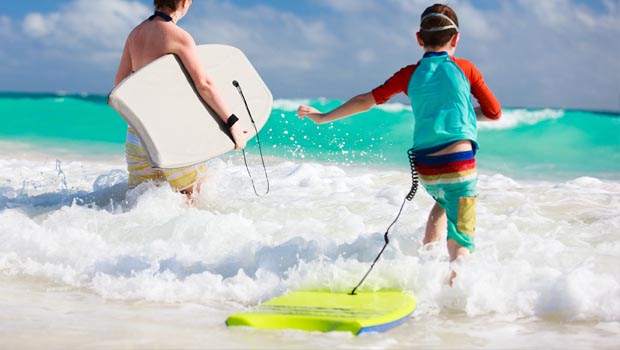The Day My Son’s CGM Went Swimming

Preparing for vacation with diabetes is a lot of work. You plan. You make lists. You pack your plethora of supplies. Then it’s time for the ride, which is always a thrill, but not always in a good way.
This past summer, after much planning and anticipation, we made it to Hawaii. Picture us on a special outing to magnificent Mauna Kea Beach on Kaunaoa Bay, standing in a place that graced the pages of Condé Nast. The surroundings were beyond spectacular. Tall coconut palms were swaying in the breeze, the sun baked the sand beneath our feet, and powerful waves beckoned the boys. My husband and oldest son headed off to snorkel while I watched our two younger sons race into the water and rediscover the joy of bodysurfing. We were in paradise!
Suddenly, the spell was broken.
“Oh no! Mom!”
My older son ran up to me, breathless, having just pulled his Dexcom receiver out of the pocket of his swim trunks. He had been bodysurfing with that expensive continuous glucose monitor in his pocket for no less than 20 minutes.
Once the soaked device was in my hand, I knew it was ruined. I had read about water damaged devices being revived with rice and hours of warm heat from an oven. But salt water? It’s corrosive.
We gathered as a family to examine the causality of our beach outing: a little wet device with no signs of life, bubbles under the window, unresponsive to touch. The first thing I thought of was the expense. How much would the replacement cost? Hundreds? We’d traveled a fair amount, but never lost or damaged a major piece of equipment.
And then there was sleep, that precious commodity for which D-parents yearn. I didn’t want to return to the pre-CGM era of our lives, that time of setting alarms throughout the night and doing the math. Life was good with our Dexcom. It wasn’t a cakewalk, quiet nights were still rare, but to return to life without a CGM? It was almost unthinkable.
Losing equipment is terrifying, and anxious moments lead to more anxious thoughts. What if it had been the Omnipod that went swimming? What if the whole diabetes bag went in? These “what ifs” can drive you crazy. And yet, as a D-parent, you have to entertain the “what ifs” to some degree. It’s because of this exercise that you go on a vacation well prepared, with a suitcase full of supplies, including: Novolog and Levemir pens, extra glucometers, loads of BG strips and more.
“What ifs” quickly become “if onlys”. If only we had a better system! If only my son’s swim trunks didn’t have pockets! This line of thinking is pointless. The reality is that “stuff” happens, even on vacation. Especially on vacation.
After some commiseration, I unceremoniously dropped the Dexcom receiver into a beach bag and headed for the ocean. Taking this cue, my son followed, anxiety subsiding. There was work to be done, but not now. The phone calls, the research, the formulation of a new nighttime game plan would all have to come later. We were in Hawaii after all, and the Pacific was calling. I rode the waves with our boys while my husband took a turn watching our things.
The next day, we purchased another receiver for the one-time replacement fee of $199. It was an expensive mistake but it could have been much worse. After five long nights and one expedited shipping fee, the cherished device was in our hands.
There are highs and lows on any vacation; diabetes has the potential to magnify them. Forgotten items, a lost bag, and broken medical devices, the lows come in all forms, but the highs of being surrounded by my favorite people in spectacular surroundings are amazing. There are risks involved when taking diabetes on vacation. What we have to gain makes it all worthwhile.
Thanks for reading this Insulin Nation article. Want more Type 1 news? Subscribe here.
Have Type 2 diabetes or know someone who does? Try Type 2 Nation, our sister publication.